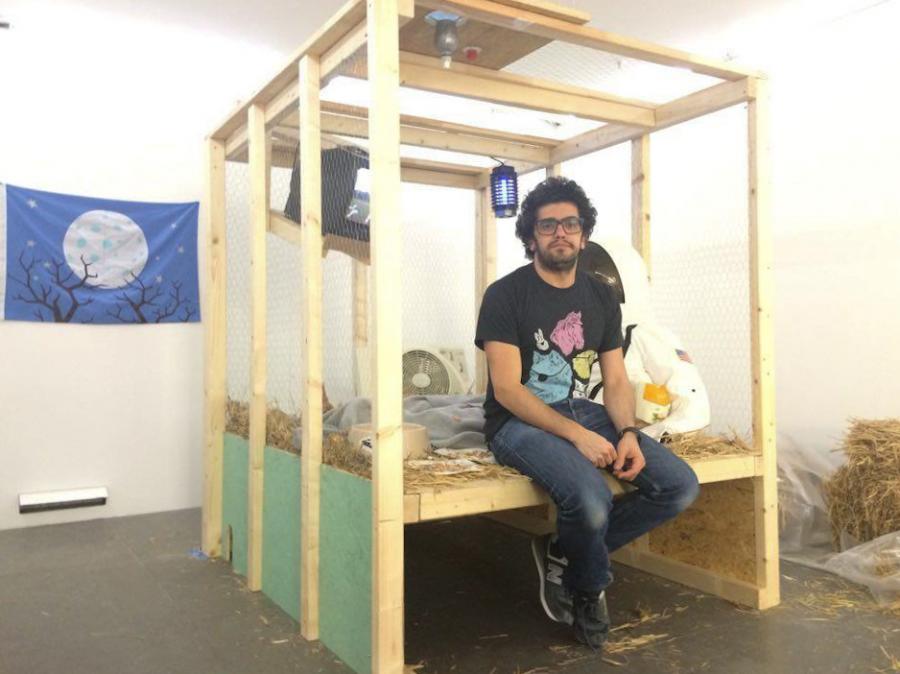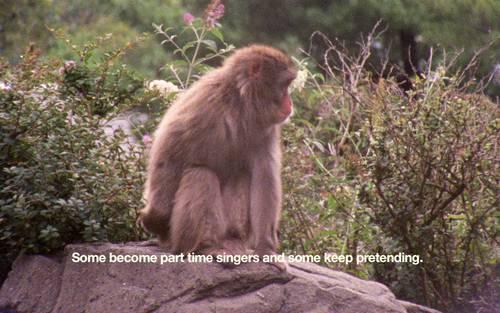Pre-interview: Basim Magdy
Pre-interview: Basim Magdy

The Deutsche Bank KunstHalle's "Artist of the Year" 2016 award went to Basim Magdy, Egyptian artist who works in a wide variety of media, using the future to take a critical look at the present. The highlight of the award – a solo exhibition at the KunstHalle – is currently in the final phase of preparation under the title "The Stars Were Aligned for a Century of New Beginnings". It is his first institutional exhibition and the biggest one to date, spanning 10 years of his artistic work.
We met up with the artist just before the opening, and got an exclusive preview of the show in the making. Basim shared some of his thoughts about the show and his artistic practice, the present and the future, and the role of humor in all of it.
What are you showing at the Deutsche Bank KunstHalle?
I am showing a slide projection piece called "A 240 Second Analysis of Failure and Hopefulness". A sculpture, "The Future of Your Head", which is made up of Christmas lights and a two-way mirror. I am also showing three films, and new big photographic piece made up of 60 photographs, comissioned by the Deutsche Bank, which will be shown for the first time here. There is also a text piece called "Clowns", and one installation called "In the Grave of Intergalactic Utopia". And also around 24 works on paper, which are made with spray paint and acrylics, gouache and watercolors, all mixed together. It is very diverse, a lot of different media.
What is specific about this show?
It is the biggest show I have ever done, and I never had such a diverse combination of works in one show. For me that is really exciting, to see them together, because I've never seen them together before. But also to see how they relate to one another, because the show is not set up in a chronological order. Films are mixed up with other works, so you walk in the room that has light, but also controlled light, and then you enter the dark room and you watch films, and then you enter another room where there are works that need light, and then you enter another room that is dark... There is no chronological order, or even order by medium. I want to see the connections between them, how things relate to each other in an unusual way, which is what I do in my work in general. I try to look at things from an unusual point of view, not the way you would see these things or understand these images at first glance. I try to present alternative understanding of things that is not the first thing you would think of when you see an image.
Could you explain the title – "The Stars Were Aligned for a Century of New Beginnings"?
It has a lot to do with the idea of time, the passing of time, past, present and future, and how things go through cycles. Time goes in cycles. Things that happened in the past are happening now and will still happen in the future, and everything comes out of everything else. The future is not going to be some science-fictional utopian time that has nothing to do with what we are living now. After the first Moon landng there were all these visions of Moon colonies, Mars colonies, floating cars, elevated highways, and all these illustrations of things that were not realistic, even based on the realities of the Sixties. It did not stem out of the reality of the Sixties. They were just completely abstract. So my point is that things are always rooted in the time before. The future will not be some crazy random place that we can't relate to, it will be exactly the very logical kind of progress of what we have now.
Where do you mainly draw inspiration from?
A lot of things. It can be anything I experience. A conversation I overhear, something I see while walking on the street., a song, a poem, what I shoot on the airplane while seeing the world from above.... I don't have anything specific, it is more about what you do with the things you see, how you understand them and how you can put these things together to present them in na different way from whatt people are used to. How to present an image in a way that tells you something more than you know about it.

How important for you is humor in art? Do you think it has the ability to inspire social change?
Humor is important in the sense that it instigates an emotional reaction, and I think that is a good entry point for any work. If a work makes you feel something, not just think something, that is really a good thing . Because feelings are something we share regardless of our backgrounds or life experiences. We feel differently, we show our feelings differently, but we all have the same feelings. On the other hand, we think differently. I became interested in this idea of making work that speaks to people's feelings, and it started with humor. The first reaction to a work of art with humor in it is that you laugh or smile. And then you start thinking about what you are looking at. It helps in that sense.
I don't even think that any kind of art can create any kind of social change. Social change is something that needs something bigger than art. Art is not that popular of a medium. Art is not TV. Contemporary art is something that a small group of people in society understands. It is a language that is not spoken or written. It's an amazing language and I love expressing myself using this language, but I also understand its limitations, and I understand that my expectations have to be realistic. I am very happy if my work says something to someone on an individual level. But this idea of masses changing their way of thinking, or change happening on a larger scale is extremely unrealistic with art.

Filmstill from "The Everyday Ritual of Solitude Hatching Monkeys", 2014. © Basim Magdy
What is at the core of your practice? What do you find most important in art?
Different things. From very personal point of view, to always find what I do exciting. To always have something to say. To always know how to say it. But at the same time, what is important is that I manage to communicate what I think, to translate what I think into what I d; that's the difficult part. I would be really happy if somebody would come just to see my work, and then wake up the next morning and think about it again. To me that is a great success. Anything more than that may or may not happen, but that's not a goal. Again, I think managing expectations is very important when you are dealing with art. because you can also be extremely delusional about what you do, and you can live in a bubble and think that what you do is really important. No, it's not really important. It's really important to me, but I don't see why it should be really important to other people. It is really important for me to show it to other people. What happens next is up to a lot of things, a lot of circumstances, including the other people. Expectations need to be managed.
What is coming next?
This show is going to travel to very good museums and I am very happy about this. In September it is going to be in a museum in Rome, and in December in the Museum of Contemporary Art in Chicago. I also have an unrelated show in October at Jeu de Paume in Paris. It is a show that is part of a program they have. This show will go to the Musuem of Contemporary Art in Bordeaux in November.
* * * * *
Basim Magdy – "The Stars Were Aligned for a Century of New Beginnings"
Deutsche Bank KunstHalle / Unter den Linden 13–15, 10117 Berlin, U Französische Str.
29/04 – 03/07/2016
more info